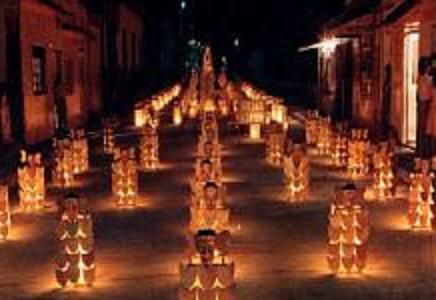By Jessie Pew, dramaturg
In America, if you ask someone what day Christmas is, you’re likely going to get a very baffled look before they respond, “December 25th?” in that tone (you know the one) that clearly says “What planet did you come from?” in only two words. Here, our worldview is very centered on evangelical traditions. Christmas Eve and Christmas Day, falling on the 24th and 25th of December respectively, are generally the two days of Christmas that we take into consideration, especially from a work perspective. Businesses are often open for at least a few hours on Christmas Eve, so in America really Christmas Day is the only true “holiday” associated with Christmas for many people. Since this is all most of us know, it can be very easy to assume that this holds true across the world.
However, nothing is really further from the truth. Depending on what country you live in or what cultures you are involved in, the sky is really the limit on what can constitute “Christmas”. Christmas is formally celebrated in over 160 countries across the world, but not all of these countries observe Christmas on December 25th. In Russia, for example, Christmas is observed on January 7th, due to the 13-day difference between the Gregorian calendar (which is what is followed in the majority of countries) and the Julian calendar. Along with this, in a few countries, like Jordan, Christmas Day is only an observed holiday from a work perspective for Christian citizens, whereas in many other countries, America included, Christmas is observed as a holiday (as far as businesses are concerned) regardless of religious identity.

Even in countries that formally recognize the 25th of December, Christmas celebrations do not happen on the same day globally. While Ukraine does formally recognize Christmas as falling on the 25th of December as of 2017, the majority of its citizens still hold the bulk of celebrations on January 7th. In Columbia, a series of parties are held for the nine days leading up to Christmas Eve (called Novena de Aguinaldos), when the biggest Christmas celebrations generally take place. As mentioned throughout Christmas Around the World, Scandinavian countries, as well as followers of various Christian denominations, celebrate Advent, falling on the four Sundays leading up to Christmas. Beyond this, many countries celebrate either December 6th or 7th. These holidays are called “St. Nicholas Day” in most European traditions, and usually involve some gift-giving, but this too isn’t consistent globally: other countries that celebrate this day often began this tradition as a way of celebrating the Immaculate Conception. In Columbia, December 7th is called Día de las Velitas or “day of the little candles” and houses and streets are covered in candles, lanterns, and other lights.

Even for those who celebrate the 25th, some are not done celebrating Christmas. Commonly misunderstood, the twelve days of Christmas actually fall after Christmas Day and are meant to represent the days of travel the wise men took to meet Jesus Christ. For those who follow this tradition, they will also celebrate January 6th as “The Epiphany” or “Three Kings’ Day.” After that many Eastern Orthodox and Catholic citizens still do not consider Christmas “over ” until Candlemas on February 2nd, forty days after Christmas. On this day, candles are blessed to be used in churches for the coming year. It’s celebrated in remembrance of Mary and Joseph taking the infant Jesus to a Jewish temple to give thanks to God for giving them a son.
If you’re feeling overwhelmed by all of that, that’s completely valid! I considered myself pretty knowledgeable about different Christmas traditions prior to this production, and now I just find myself overwhelmed by the sheer amount of traditions and celebrations that are observed around a single blanket holiday. And while these are examples that come from a variety of religious practices, it’s also important to remember this is a Christian holiday. Imagine how insane it must be to try and keep track of holy days and celebrations across the wonderfully diverse range of religions practiced throughout the world! It’s truly such an incredible aspect of humanity: we genuinely look for as many reasons to celebrate and rejoice in community as we possibly can. I think it matters less that we celebrate in an easily or universally recognizable way, and matters more that we are celebrating and continuing to find joy in our traditions.

